工业设计的定义
- 格式:pdf
- 大小:149.54 KB
- 文档页数:5
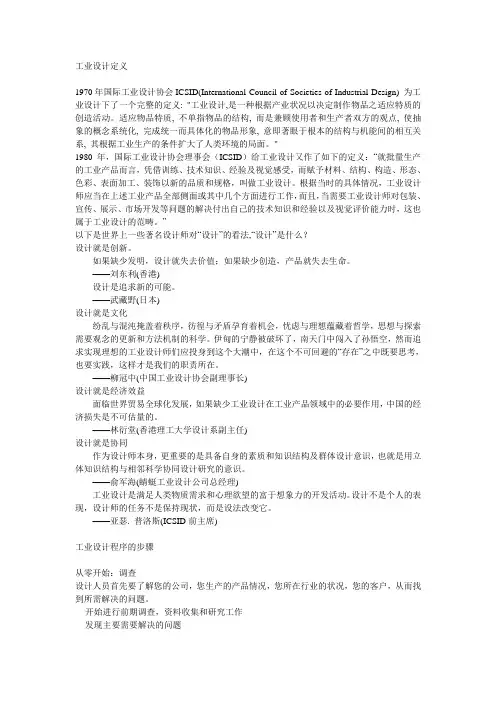
工业设计定义1970年国际工业设计协会ICSID(International Council of Societies of Industrial Design) 为工业设计下了一个完整的定义: "工业设计,是一种根据产业状况以决定制作物品之适应特质的创造活动。
适应物品特质, 不单指物品的结构, 而是兼顾使用者和生产者双方的观点, 使抽象的概念系统化, 完成统一而具体化的物品形象, 意即著眼于根本的结构与机能间的相互关系, 其根据工业生产的条件扩大了人类环境的局面。
"1980年,国际工业设计协会理事会(ICSID)给工业设计又作了如下的定义:“就批量生产的工业产品而言,凭借训练、技术知识、经验及视觉感受,而赋予材料、结构、构造、形态、色彩、表面加工、装饰以新的品质和规格,叫做工业设计。
根据当时的具体情况,工业设计师应当在上述工业产品全部侧面或其中几个方面进行工作,而且,当需要工业设计师对包装、宣传、展示、市场开发等问题的解决付出自己的技术知识和经验以及视觉评价能力时,这也属于工业设计的范畴。
”以下是世界上一些著名设计师对“设计”的看法,“设计”是什么?设计就是创新。
如果缺少发明,设计就失去价值;如果缺少创造,产品就失去生命。
——刘东利(香港)设计是追求新的可能。
——武藏野(日本)设计就是文化纷乱与混沌掩盖着秩序,彷徨与矛盾孕育着机会,忧虑与理想蕴藏着哲学,思想与探索需要观念的更新和方法机制的科学。
伊甸的宁静被破坏了,南天门中闯入了孙悟空,然而追求实现理想的工业设计师们应投身到这个大潮中,在这个不可回避的“存在”之中既要思考,也要实践,这样才是我们的职责所在。
——柳冠中(中国工业设计协会副理事长)设计就是经济效益面临世界贸易全球化发展,如果缺少工业设计在工业产品领域中的必要作用,中国的经济损失是不可估量的。
——林衍堂(香港理工大学设计系副主任)设计就是协同作为设计师本身,更重要的是具备自身的素质和知识结构及群体设计意识,也就是用立体知识结构与相邻科学协同设计研究的意识。
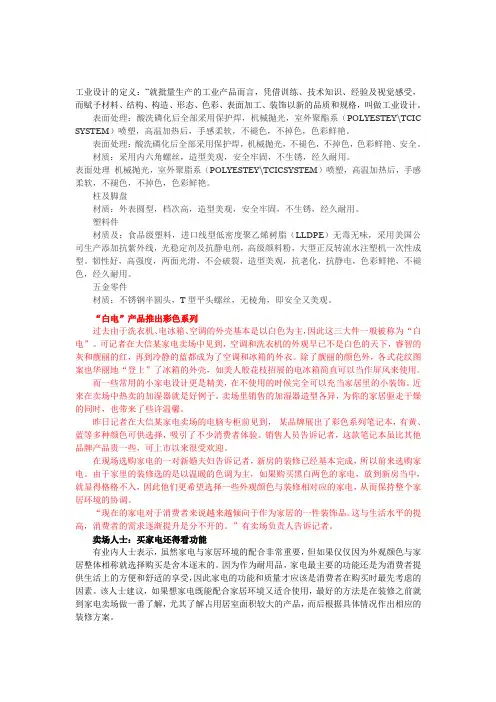
工业设计的定义:“就批量生产的工业产品而言,凭借训练、技术知识、经验及视觉感受,而赋予材料、结构、构造、形态、色彩、表面加工、装饰以新的品质和规格,叫做工业设计。
表面处理:酸洗磷化后全部采用保护焊,机械抛光,室外聚酯系(POLYESTEY\TCIC SYSTEM)喷塑,高温加热后,手感柔软,不褪色,不掉色,色彩鲜艳。
表面处理:酸洗磷化后全部采用保护焊,机械抛光,不褪色,不掉色,色彩鲜艳、安全。
材质:采用内六角螺丝,造型美观,安全牢固,不生锈,经久耐用。
表面处理机械抛光,室外聚脂系(POLYESTEY\TCICSYSTEM)喷塑,高温加热后,手感柔软,不褪色,不掉色,色彩鲜艳。
柱及脚盘材质:外表圆型,档次高,造型美观,安全牢固,不生锈,经久耐用。
塑料件材质及:食品级塑料,进口线型低密度聚乙烯树脂(LLDPE)无毒无味,采用美国公司生产添加抗紫外线,光稳定剂及抗静电剂,高级颜料粉,大型正反转流水注塑机一次性成型。
韧性好,高强度,两面光滑,不会破裂,造型美观,抗老化,抗静电,色彩鲜艳,不褪色,经久耐用。
五金零件材质:不锈钢半圆头,T型平头螺丝,无棱角,即安全又美观。
“白电”产品推出彩色系列过去由于洗衣机、电冰箱、空调的外壳基本是以白色为主,因此这三大件一般被称为“白电”。
可记者在大信某家电卖场中见到,空调和洗衣机的外观早已不是白色的天下,睿智的灰和靓丽的红,再到冷静的蓝都成为了空调和冰箱的外衣。
除了靓丽的颜色外,各式花纹图案也华丽地“登上”了冰箱的外壳,如美人般花枝招展的电冰箱简直可以当作屏风来使用。
而一些常用的小家电设计更是精美,在不使用的时候完全可以充当家居里的小装饰。
近来在卖场中热卖的加湿器就是好例子。
卖场里销售的加湿器造型各异,为你的家居驱走干燥的同时,也带来了些许温馨。
昨日记者在大信某家电卖场的电脑专柜前见到,某品牌展出了彩色系列笔记本,有黄、蓝等多种颜色可供选择,吸引了不少消费者体验。
销售人员告诉记者,这款笔记本虽比其他品牌产品贵一些,可上市以来很受欢迎。
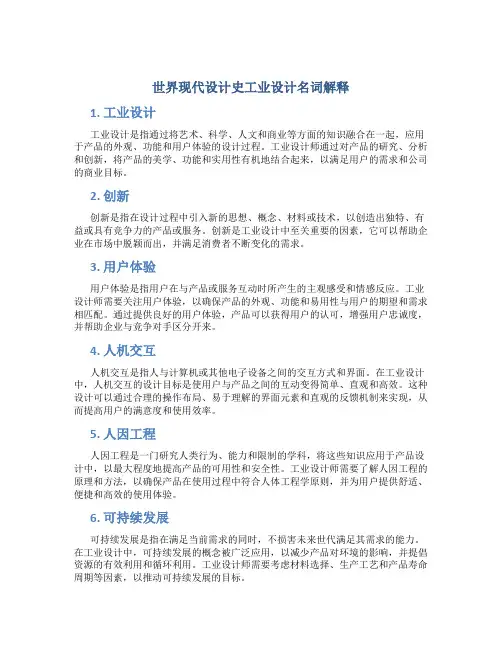
世界现代设计史工业设计名词解释1. 工业设计工业设计是指通过将艺术、科学、人文和商业等方面的知识融合在一起,应用于产品的外观、功能和用户体验的设计过程。
工业设计师通过对产品的研究、分析和创新,将产品的美学、功能和实用性有机地结合起来,以满足用户的需求和公司的商业目标。
2. 创新创新是指在设计过程中引入新的思想、概念、材料或技术,以创造出独特、有益或具有竞争力的产品或服务。
创新是工业设计中至关重要的因素,它可以帮助企业在市场中脱颖而出,并满足消费者不断变化的需求。
3. 用户体验用户体验是指用户在与产品或服务互动时所产生的主观感受和情感反应。
工业设计师需要关注用户体验,以确保产品的外观、功能和易用性与用户的期望和需求相匹配。
通过提供良好的用户体验,产品可以获得用户的认可,增强用户忠诚度,并帮助企业与竞争对手区分开来。
4. 人机交互人机交互是指人与计算机或其他电子设备之间的交互方式和界面。
在工业设计中,人机交互的设计目标是使用户与产品之间的互动变得简单、直观和高效。
这种设计可以通过合理的操作布局、易于理解的界面元素和直观的反馈机制来实现,从而提高用户的满意度和使用效率。
5. 人因工程人因工程是一门研究人类行为、能力和限制的学科,将这些知识应用于产品设计中,以最大程度地提高产品的可用性和安全性。
工业设计师需要了解人因工程的原理和方法,以确保产品在使用过程中符合人体工程学原则,并为用户提供舒适、便捷和高效的使用体验。
6. 可持续发展可持续发展是指在满足当前需求的同时,不损害未来世代满足其需求的能力。
在工业设计中,可持续发展的概念被广泛应用,以减少产品对环境的影响,并提倡资源的有效利用和循环利用。
工业设计师需要考虑材料选择、生产工艺和产品寿命周期等因素,以推动可持续发展的目标。
7. 线条线条在工业设计中是指产品表面的视觉轮廓或线条形状。
设计师可以通过线条的运用来表达产品的动感、稳定感或流畅感,以及传达产品的功能特性和品牌形象。
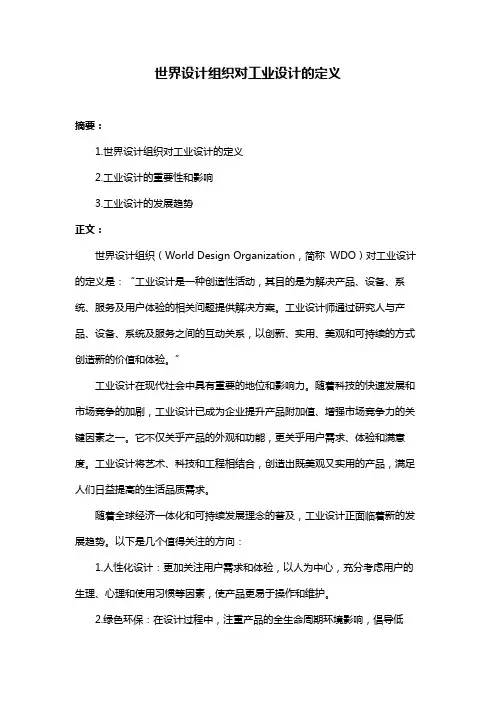
世界设计组织对工业设计的定义摘要:1.世界设计组织对工业设计的定义2.工业设计的重要性和影响3.工业设计的发展趋势正文:世界设计组织(World Design Organization,简称WDO)对工业设计的定义是:“工业设计是一种创造性活动,其目的是为解决产品、设备、系统、服务及用户体验的相关问题提供解决方案。
工业设计师通过研究人与产品、设备、系统及服务之间的互动关系,以创新、实用、美观和可持续的方式创造新的价值和体验。
”工业设计在现代社会中具有重要的地位和影响力。
随着科技的快速发展和市场竞争的加剧,工业设计已成为企业提升产品附加值、增强市场竞争力的关键因素之一。
它不仅关乎产品的外观和功能,更关乎用户需求、体验和满意度。
工业设计将艺术、科技和工程相结合,创造出既美观又实用的产品,满足人们日益提高的生活品质需求。
随着全球经济一体化和可持续发展理念的普及,工业设计正面临着新的发展趋势。
以下是几个值得关注的方向:1.人性化设计:更加关注用户需求和体验,以人为中心,充分考虑用户的生理、心理和使用习惯等因素,使产品更易于操作和维护。
2.绿色环保:在设计过程中,注重产品的全生命周期环境影响,倡导低碳、绿色、可持续的设计理念,减少资源消耗和环境污染。
3.数字化技术:充分利用计算机辅助设计(CAD)、计算机辅助制造(CAM)等数字化技术,提高设计效率和质量,缩短产品开发周期。
4.跨界融合:工业设计与其他领域(如艺术、科技、工程等)的融合,拓宽设计视野和创新空间,形成多元化的设计风格和解决方案。
5.智能化趋势:随着物联网、大数据、人工智能等技术的发展,工业设计将更加注重产品的智能化和互联互通,为用户提供更加便捷、高效的服务。
总之,工业设计在现代社会中发挥着重要作用,它不仅影响着产品的外观和功能,还关系到用户体验和满意度。
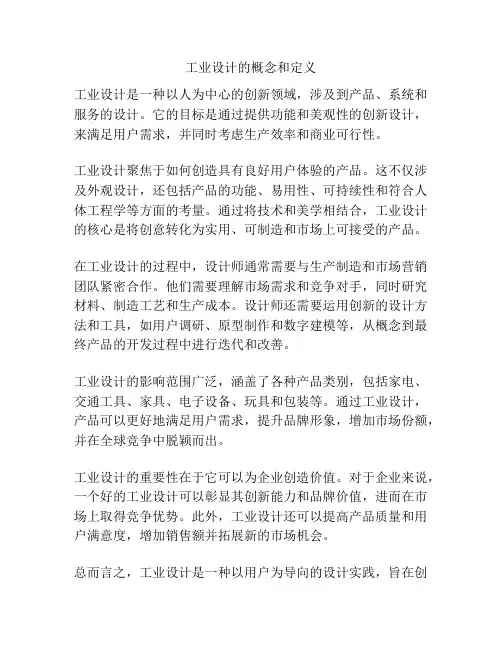
工业设计的概念和定义
工业设计是一种以人为中心的创新领域,涉及到产品、系统和服务的设计。
它的目标是通过提供功能和美观性的创新设计,来满足用户需求,并同时考虑生产效率和商业可行性。
工业设计聚焦于如何创造具有良好用户体验的产品。
这不仅涉及外观设计,还包括产品的功能、易用性、可持续性和符合人体工程学等方面的考量。
通过将技术和美学相结合,工业设计的核心是将创意转化为实用、可制造和市场上可接受的产品。
在工业设计的过程中,设计师通常需要与生产制造和市场营销团队紧密合作。
他们需要理解市场需求和竞争对手,同时研究材料、制造工艺和生产成本。
设计师还需要运用创新的设计方法和工具,如用户调研、原型制作和数字建模等,从概念到最终产品的开发过程中进行迭代和改善。
工业设计的影响范围广泛,涵盖了各种产品类别,包括家电、交通工具、家具、电子设备、玩具和包装等。
通过工业设计,产品可以更好地满足用户需求,提升品牌形象,增加市场份额,并在全球竞争中脱颖而出。
工业设计的重要性在于它可以为企业创造价值。
对于企业来说,一个好的工业设计可以彰显其创新能力和品牌价值,进而在市场上取得竞争优势。
此外,工业设计还可以提高产品质量和用户满意度,增加销售额并拓展新的市场机会。
总而言之,工业设计是一种以用户为导向的设计实践,旨在创
造具有功能性、美观性和商业可行性的产品。
它结合了技术、美学和市场需求,将创意转化为具有竞争力的产品,并为企业带来长期的商业价值。
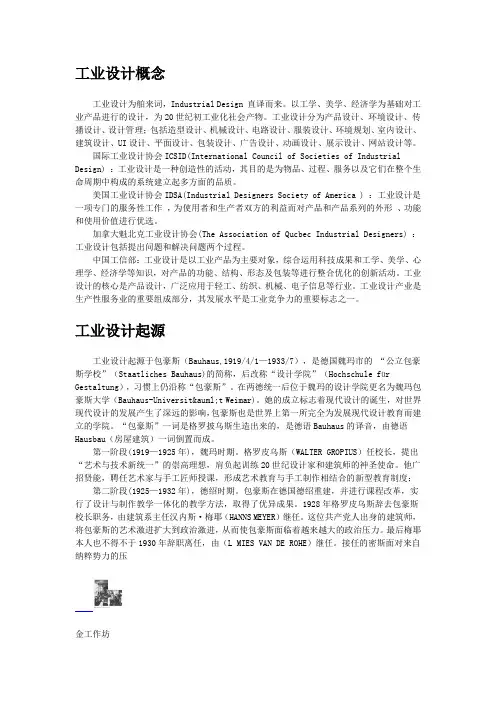
工业设计概念工业设计为舶来词,Industrial Design 直译而来。
以工学、美学、经济学为基础对工业产品进行的设计,为20世纪初工业化社会产物。
工业设计分为产品设计、环境设计、传播设计、设计管理;包括造型设计、机械设计、电路设计、服装设计、环境规划、室内设计、建筑设计、UI设计、平面设计、包装设计、广告设计、动画设计、展示设计、网站设计等。
国际工业设计协会ICSID(International Council of Societies of Industrial Design) :工业设计是一种创造性的活动,其目的是为物品、过程、服务以及它们在整个生命周期中构成的系统建立起多方面的品质。
美国工业设计协会IDSA(Industrial Designers Society of America ) :工业设计是一项专门的服务性工作,为使用者和生产者双方的利益而对产品和产品系列的外形、功能和使用价值进行优选。
加拿大魁北克工业设计协会(The Association of Qucbec Industrial Designers) :工业设计包括提出问题和解决问题两个过程。
中国工信部:工业设计是以工业产品为主要对象,综合运用科技成果和工学、美学、心理学、经济学等知识,对产品的功能、结构、形态及包装等进行整合优化的创新活动。
工业设计的核心是产品设计,广泛应用于轻工、纺织、机械、电子信息等行业。
工业设计产业是生产性服务业的重要组成部分,其发展水平是工业竞争力的重要标志之一。
工业设计起源工业设计起源于包豪斯(Bauhaus,1919/4/1—1933/7),是德国魏玛市的“公立包豪斯学校”(Staatliches Bauhaus)的简称,后改称“设计学院”(Hochschule für Gestaltung),习惯上仍沿称“包豪斯”。
在两德统一后位于魏玛的设计学院更名为魏玛包豪斯大学(Bauhaus-Universität Weimar)。
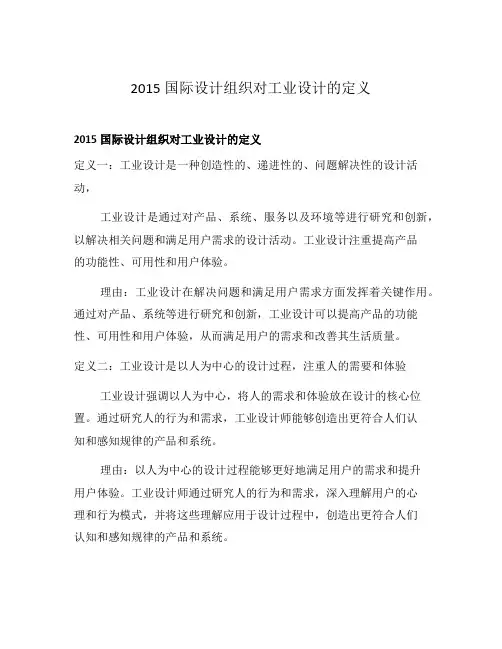
2015国际设计组织对工业设计的定义2015国际设计组织对工业设计的定义定义一:工业设计是一种创造性的、递进性的、问题解决性的设计活动,工业设计是通过对产品、系统、服务以及环境等进行研究和创新,以解决相关问题和满足用户需求的设计活动。
工业设计注重提高产品的功能性、可用性和用户体验。
理由:工业设计在解决问题和满足用户需求方面发挥着关键作用。
通过对产品、系统等进行研究和创新,工业设计可以提高产品的功能性、可用性和用户体验,从而满足用户的需求和改善其生活质量。
定义二:工业设计是以人为中心的设计过程,注重人的需要和体验工业设计强调以人为中心,将人的需求和体验放在设计的核心位置。
通过研究人的行为和需求,工业设计师能够创造出更符合人们认知和感知规律的产品和系统。
理由:以人为中心的设计过程能够更好地满足用户的需求和提升用户体验。
工业设计师通过研究人的行为和需求,深入理解用户的心理和行为模式,并将这些理解应用于设计过程中,创造出更符合人们认知和感知规律的产品和系统。
定义三:工业设计是将艺术、科学、技术和商业融合的创造性活动工业设计是一门融合了艺术、科学、技术和商业的创造性活动。
通过运用艺术的美学原则、科学的研究方法、技术的创新和商业的考量,工业设计师能够创造出具有艺术性、实用性和商业价值的产品和系统。
理由:工业设计是一门复合型的学科,需要涵盖多个领域的知识和技能。
融合了艺术、科学、技术和商业的创造性活动,能够推动产品和系统的创新发展,同时满足人们对美感、实用性和商业价值的需求。
书籍简介:《工业设计原理与方法》《工业设计原理与方法》是由金德兰(DeVries Kirsten)等合著的一本经典工业设计专著。
该书系统地介绍了工业设计的原理、方法和实践,在设计思维、人机交互、创新设计等方面提供了丰富的案例和实用的工具。
通过阅读该书,读者能够更深入地理解工业设计的本质和作用,提升工业设计的能力和水平。
该书不仅适合工业设计师和学生阅读,也适合对工业设计感兴趣的人士参考。
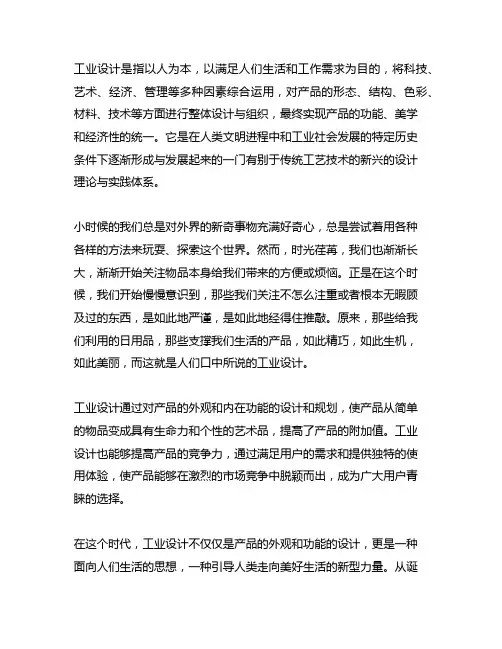
工业设计是指以人为本,以满足人们生活和工作需求为目的,将科技、艺术、经济、管理等多种因素综合运用,对产品的形态、结构、色彩、材料、技术等方面进行整体设计与组织,最终实现产品的功能、美学和经济性的统一。
它是在人类文明进程中和工业社会发展的特定历史条件下逐渐形成与发展起来的一门有别于传统工艺技术的新兴的设计理论与实践体系。
小时候的我们总是对外界的新奇事物充满好奇心,总是尝试着用各种各样的方法来玩耍、探索这个世界。
然而,时光荏苒,我们也渐渐长大,渐渐开始关注物品本身给我们带来的方便或烦恼。
正是在这个时候,我们开始慢慢意识到,那些我们关注不怎么注重或者根本无暇顾及过的东西,是如此地严谨,是如此地经得住推敲。
原来,那些给我们利用的日用品,那些支撑我们生活的产品,如此精巧,如此生机,如此美丽,而这就是人们口中所说的工业设计。
工业设计通过对产品的外观和内在功能的设计和规划,使产品从简单的物品变成具有生命力和个性的艺术品,提高了产品的附加值。
工业设计也能够提高产品的竞争力,通过满足用户的需求和提供独特的使用体验,使产品能够在激烈的市场竞争中脱颖而出,成为广大用户青睐的选择。
在这个时代,工业设计不仅仅是产品的外观和功能的设计,更是一种面向人们生活的思想,一种引导人类走向美好生活的新型力量。
从诞生之初起,工业设计就被赋予了巨大的使命,这就是,通过对产品的深度设计和人文关怀,改善人们的生活品质,推动社会的持续发展。
正是因为工业设计的重要性和独特价值,工业设计已经成为了现代社会中不可或缺的一环,渗透在我们生活的方方面面。
然而,随着社会的不断发展,人们对于工业设计的要求也不断提高,对工业设计师的素质和能力提出了更高的要求。
工业设计的定义、概念、发展历程等问题也越来越受到人们的重视。
以下是工业设计的概念、定义及其发展历程的详细阐述:一、工业设计的概念1.1 工业设计的定义工业设计是指通过对产品的综合性设计,包括外观设计、结构设计、功能设计等方面的设计,使产品在满足功能需求的具有良好的造型、美观、易用等特点。
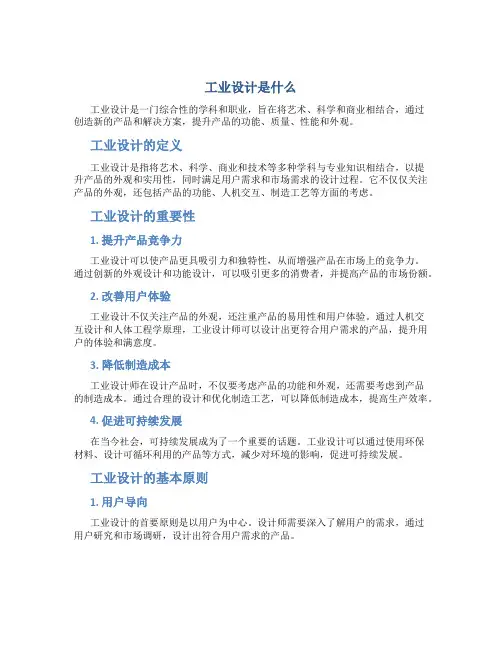
工业设计是什么工业设计是一门综合性的学科和职业,旨在将艺术、科学和商业相结合,通过创造新的产品和解决方案,提升产品的功能、质量、性能和外观。
工业设计的定义工业设计是指将艺术、科学、商业和技术等多种学科与专业知识相结合,以提升产品的外观和实用性,同时满足用户需求和市场需求的设计过程。
它不仅仅关注产品的外观,还包括产品的功能、人机交互、制造工艺等方面的考虑。
工业设计的重要性1. 提升产品竞争力工业设计可以使产品更具吸引力和独特性,从而增强产品在市场上的竞争力。
通过创新的外观设计和功能设计,可以吸引更多的消费者,并提高产品的市场份额。
2. 改善用户体验工业设计不仅关注产品的外观,还注重产品的易用性和用户体验。
通过人机交互设计和人体工程学原理,工业设计师可以设计出更符合用户需求的产品,提升用户的体验和满意度。
3. 降低制造成本工业设计师在设计产品时,不仅要考虑产品的功能和外观,还需要考虑到产品的制造成本。
通过合理的设计和优化制造工艺,可以降低制造成本,提高生产效率。
4. 促进可持续发展在当今社会,可持续发展成为了一个重要的话题。
工业设计可以通过使用环保材料、设计可循环利用的产品等方式,减少对环境的影响,促进可持续发展。
工业设计的基本原则1. 用户导向工业设计的首要原则是以用户为中心。
设计师需要深入了解用户的需求,通过用户研究和市场调研,设计出符合用户需求的产品。
2. 创新性工业设计需要具备创新性,为用户提供新颖、独特的产品和解决方案。
创新不仅指产品的外观设计,还包括产品的功能设计和技术创新。
3. 可行性工业设计不仅要追求创新,还要注重产品的可行性。
设计师需要考虑到产品的制造工艺、成本等因素,确保设计方案的可行性。
4. 简约性工业设计要追求简约、精练的设计风格。
简约的设计不仅美观,还易于用户理解和操作。
5. 可持续性工业设计需要考虑到产品的可持续性。
设计师要选择环保材料,设计可循环利用的产品,减少对环境的影响。
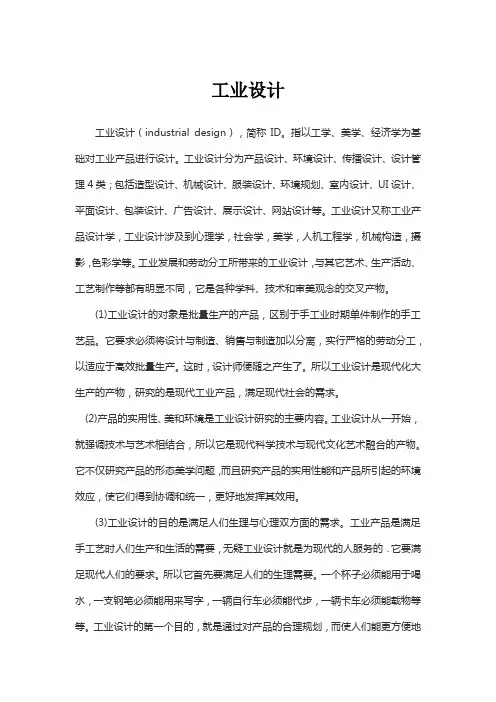
工业设计工业设计(industrial design),简称ID。
指以工学、美学、经济学为基础对工业产品进行设计。
工业设计分为产品设计、环境设计、传播设计、设计管理4类;包括造型设计、机械设计、服装设计、环境规划、室内设计、UI设计、平面设计、包装设计、广告设计、展示设计、网站设计等。
工业设计又称工业产品设计学,工业设计涉及到心理学,社会学,美学,人机工程学,机械构造,摄影,色彩学等。
工业发展和劳动分工所带来的工业设计,与其它艺术、生产活动、工艺制作等都有明显不同,它是各种学科、技术和审美观念的交叉产物。
(1)工业设计的对象是批量生产的产品,区别于手工业时期单件制作的手工艺品。
它要求必须将设计与制造、销售与制造加以分离,实行严格的劳动分工,以适应于高效批量生产。
这时,设计师便随之产生了。
所以工业设计是现代化大生产的产物,研究的是现代工业产品,满足现代社会的需求。
(2)产品的实用性、美和环境是工业设计研究的主要内容。
工业设计从一开始,就强调技术与艺术相结合,所以它是现代科学技术与现代文化艺术融合的产物。
它不仅研究产品的形态美学问题,而且研究产品的实用性能和产品所引起的环境效应,使它们得到协调和统一,更好地发挥其效用。
(3)工业设计的目的是满足人们生理与心理双方面的需求。
工业产品是满足手工艺时人们生产和生活的需要,无疑工业设计就是为现代的人服务的.它要满足现代人们的要求。
所以它首先要满足人们的生理需要。
一个杯子必须能用于喝水,一支钢笔必须能用来写字,一辆自行车必须能代步,一辆卡车必须能载物等等。
工业设计的第一个目的,就是通过对产品的合理规划,而使人们能更方便地使用它们,使其更好地发挥效力。
在研究产品性能的基础上,工业设计还通过合理的造型手段,使产品能够具备富有时代精神,符合产品性能、与环境协调的产品形态,使人们得到美的享受。
(4)工业设计是有组织的活动。
在手工业时代,手工艺人们大多单枪匹马,独自作战。
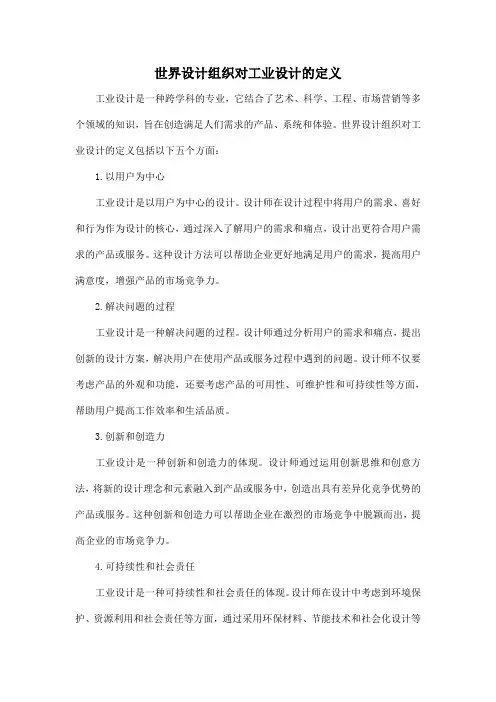
世界设计组织对工业设计的定义工业设计是一种跨学科的专业,它结合了艺术、科学、工程、市场营销等多个领域的知识,旨在创造满足人们需求的产品、系统和体验。
世界设计组织对工业设计的定义包括以下五个方面:1.以用户为中心工业设计是以用户为中心的设计。
设计师在设计过程中将用户的需求、喜好和行为作为设计的核心,通过深入了解用户的需求和痛点,设计出更符合用户需求的产品或服务。
这种设计方法可以帮助企业更好地满足用户的需求,提高用户满意度,增强产品的市场竞争力。
2.解决问题的过程工业设计是一种解决问题的过程。
设计师通过分析用户的需求和痛点,提出创新的设计方案,解决用户在使用产品或服务过程中遇到的问题。
设计师不仅要考虑产品的外观和功能,还要考虑产品的可用性、可维护性和可持续性等方面,帮助用户提高工作效率和生活品质。
3.创新和创造力工业设计是一种创新和创造力的体现。
设计师通过运用创新思维和创意方法,将新的设计理念和元素融入到产品或服务中,创造出具有差异化竞争优势的产品或服务。
这种创新和创造力可以帮助企业在激烈的市场竞争中脱颖而出,提高企业的市场竞争力。
4.可持续性和社会责任工业设计是一种可持续性和社会责任的体现。
设计师在设计中考虑到环境保护、资源利用和社会责任等方面,通过采用环保材料、节能技术和社会化设计等手段,创造出符合可持续发展要求的产品或服务。
这种可持续性和社会责任可以帮助企业树立良好的社会形象,提高企业的社会声誉。
5.跨学科合作工业设计是一种跨学科合作的过程。
设计师需要与多个领域的专业人士合作,包括产品开发、市场营销、生产制造等方面的人员。
通过跨学科的合作,设计师可以更好地理解用户需求和市场趋势,同时也可以提高产品的开发效率和生产质量。
这种跨学科合作可以帮助企业更好地实现产品设计和生产的目标,提高企业的综合竞争力。
1、名词解释A:工业设计:答:工业设计是一个外来名词,由英语Industrial Design直译而来。
在我国曾被称为工业美术设计、产品造型设计、产品设计等。
近年统一称为“工业设计”。
工业设计的定义是动态发展的,在不同国家、不同时期有着不同的定义。
在1954年布鲁塞尔举办的工业设计教育研讨会上所定义的工业设计是一种创造性的活动,旨在确定工业产品的外形质量。
虽然外形质量也包括外观特征,但主要指同时考虑生产者和使用者利益的结构和功能关系。
这种关系把一个矽统变成为均衡的整体。
同时工业设计包括工业设计产生所需的人类环境的一切方面。
1980年,国际工业设计协会联合会(ICSID)为工业设计下的定义为:对批量生产的工业产品,凭借训练、技术、经验及视觉感受,赋予产品以材料、结构、形态、色彩、表面加工及装饰、新的质量和规格、性能,叫工业设计。
当需要工业设计师对包装、宣传、市场开发等方面开展工作,并付出自己的技术知识和经验时,也属于工业设计的范畴。
工业设计的核心是产品设计。
2001年国际工业设计协会联合会(ICSID)2001年的《设计的定义》目的:设计是一种创造性的活动,其目的是综合考虑并提高物品、过程鼓舞以及他们在生命周期中构成的系统的质量。
因此,设计即使创新技术人性化的重要因素,也是经济文化交流的关键因素。
B:水晶宫水晶宫是英国伦敦一个以钢铁为骨架、玻璃为主要建材的建筑,是十九世纪的英国建筑奇观之一。
作为工业革命的发源地,英国在1851年,由维多利亚女王和他的丈夫阿尔伯特公爵发起组织了世界上第一次工业产品博览会。
会上展出了各种工业产品(包括传统手工业产品)25万件,会场便是著名的“水晶宫”。
当时由于时间关系,博览会的主办者被迫接受了来自皇家园艺总监约瑟夫·派克斯顿的救急方案——由钢铁骨架和平板玻璃组装而成的花房式大厅。
派克斯顿擅长用钢铁和玻璃来建造温室。
他采用装配温室的方法建成了“水晶宫”玻璃铁架结构的庞大外壳。
工业设计是一个外来名词,由英语Industrial Design直译而来。
在我国曾被称为工业美术设计、产品造型设计、产品设计等。
近年统一称为“工业设计”。
1980年,国际工业设计协会联合会为工业设计下的定义为:对批量生产的工业产品,凭借训练、技术、经验及视觉感受,赋予产品以材料、结构、形态、色彩、表面加工以及装饰以新的质量和性能。
当需要工业设计师对包装、宣传、市场开发等方面开展工作,并付出自己的技术知识和经验时,也属于工业设计的范畴。
工业设计的核心是产品设计。
批量生产的工业产品,无论是日常生活消费品还是生产资料,都属于工业设计的范畴。
如:日用陶瓷、玻璃器皿、文具、家具;各类家用电器;机床、医疗器械、计算机;自行车、摩托车、汽车、火车、飞机、轮船;建筑物及其内外装饰等。
工业设计是工业现代化和市场竞争的必然产物,其设计对象是以工业化方法批量生产的产品,工业设计对现代人类生活有着巨大的影响,同时又受制于生产与生活的现实水平。
工业设计过程可分为收集和选择信息、选择产品目标、构思产品形象、制定研究开发计划,产品具体设计这几个阶段。
工业设计不仅涉及到一系列传统学科,如材料力学、结构力学、强度理论等,还涉及到许多新兴学科,如人机工程、价值工程、仿生学、设计美学等。
计算机辅助设计(CAD)已成为现代工业设计的最重要的手段。
工业设计要注意遵循以下原则:创造性原则;市场需求原则;使用者优先原则;企业目标原则;易于掌握原则;美观性原则;保护生态环境原则。
美、日、德等工业发达国家的工业设计师不仅数量多,而且水平高,设计理论与设计手段均属世界先进水平,其工业发展亦因此而多方受益。
我国现阶段工业设计的对策是:一方面,对那些已经拥有先进机器设备,机械化、自动化程度较高的大批量生产的企业,尽可能的采用先进的设计理论与设计方法,对其产品进行开发、设计;另一方面,对那些技术装备较落后,手工劳动比重较大的小型企业和乡镇企业的产品加强常规设计与技术转移,使其产品获得一定程度的技术进步。
工业设计360度完全解读摘要:一、工业设计的概述- 工业设计的定义- 工业设计的重要性- 工业设计的历史发展二、工业设计的基本原则- 功能性与实用性- 美学与审美性- 技术性与经济性- 可持续性与环保性三、工业设计的主要流程- 设计需求分析- 概念设计- 详细设计- 制作原型- 测试与评估- 量产四、工业设计的应用领域- 产品设计- 交通工具设计- 医疗器械设计- 家居设计- 服装设计五、工业设计的前景与挑战- 人工智能与工业设计- 可持续性与工业设计- 工业设计创新与市场需求正文:工业设计360 度完全解读一、工业设计的概述工业设计是指通过专业的技术手段,对产品、交通工具、医疗器械、家居、服装等工业产品进行功能、美学、技术、经济、环保等多方面的设计。
工业设计不仅是为产品外观造型进行设计,更重要的是为产品的使用功能、操作方式、生产工艺等方面提供解决方案。
工业设计在提高产品竞争力的同时,也极大地提高了人们的生活质量。
二、工业设计的基本原则工业设计需要遵循功能性与实用性、美学与审美性、技术性与经济性、可持续性与环保性等基本原则。
功能性是指产品设计要满足用户的需求,实用性是指产品设计要方便用户使用;美学与审美性是指产品设计要符合大众审美,具有一定的艺术价值;技术性与经济性是指产品设计要在技术上可行,同时要控制成本;可持续性与环保性是指产品设计要考虑产品的生命周期,减少对环境的影响。
三、工业设计的主要流程工业设计的主要流程包括设计需求分析、概念设计、详细设计、制作原型、测试与评估、量产等步骤。
首先,设计师需要对产品需求进行分析,明确设计目标;然后进行概念设计,提出创新的设计方案;接着进行详细设计,对产品细节进行设计;然后制作原型,对设计方案进行验证;最后进行测试与评估,对产品进行优化,并准备量产。
四、工业设计的应用领域工业设计广泛应用于产品设计、交通工具设计、医疗器械设计、家居设计、服装设计等领域。
随着科技的发展,工业设计已经不再局限于传统的产品设计,而是向更多的领域拓展,如交互设计、服务设计等。
gong工业设计的概念定义-回复工业设计是基于工业生产的需求,通过整合艺术、科学和技术,创造出具有功能性、美观性和人性化的产品和系统的设计领域。
它涵盖了从产品的外观设计到用户体验的各个方面,旨在提升产品的竞争力和用户满意度。
下面我将逐步解释和讨论工业设计概念及其定义。
第一步:工业设计的由来工业设计的概念起源于20世纪初期的欧洲,当时由于工业化的推进和市场的扩大,人们开始重视通过设计来提高产品的质量和竞争力。
工业设计的兴起与工业革命和建立在此基础上的现代工业社会密不可分。
其定义逐渐明确,从最初的单纯注重外观美学,发展到考虑人机交互、环境可持续性等更广泛的方面。
第二步:工业设计的核心原则工业设计的核心原则是“功能、形式和用户体验相结合”。
功能性是指产品能够实现预期的功能和目标。
形式美观是指产品外观的设计与造型的优雅和美感。
用户体验是指用户与产品或系统进行交互时所产生的感知、处理和评估的总体经验。
这三个原则相辅相成,缺一不可。
第三步:工业设计的重要性工业设计在产品开发过程中起到了至关重要的作用。
首先,它可以提高产品的竞争力,通过注重外观和功能的设计,吸引消费者的目光,增强产品的市场占有率。
其次,工业设计可以提升用户体验,使用户在使用产品时感到舒适、方便和愉悦。
此外,工业设计还可以优化产品的制造和生产流程,提高效率和降低成本。
第四步:工业设计的主要领域和应用工业设计的领域非常广泛,涵盖了产品、交通工具、家居用品、电子设备、包装等多个领域。
在产品设计方面,工业设计师需要考虑产品的功能、造型、材料选择、人机交互等因素。
在交通工具的设计中,工业设计师需要关注安全性、舒适度和燃油效率等方面。
而在家居用品和电子设备方面,工业设计师需要考虑产品的实用性、美观度和用户体验。
第五步:工业设计与可持续发展的关系工业设计在可持续发展中扮演着重要的角色。
设计师需要考虑产品的环保性和可回收性,减少对自然资源的消耗和环境的负担。
工业设计的定义
国际工业设计协会对工业设计的定义
1970年国际工业设计协会ICSID(International Council of Societies of Industrial Design)为工业设计下了一个完整的定义:“工业设计,是一种根据产业状况以决定制作物品之适应特质的创造活动。
适应物品特质,不单指物品的结构,而是兼顾使用者和生产者双方的观点,使抽象的概念系统化,完成统一而具体化的物品形象,意即着眼于根本的结构与机能间的相互关系,其根据工业生产的条件扩大了人类环境的局面。
”
1980年国际工业设计协会理事会(ICSID)给工业设计更新的定义:“就批量生产的工业产品而言,凭借训练、技术知识、经验及视觉感受,而赋予材料、结构、构造、形态、色彩、表面加工、装饰以新的品质和规格,叫做工业设计。
根据当时的具体情况,工业设计师应当在上述工业产品全部侧面或其中几个方面进行工作,而且,当需要工业设计师对包装、宣传、展示、市场开发等问题的解决付出自己的技术知识和经验以及视觉评价能力时,这也属于工业设计的范畴。
”
2006年国际工业设计协会理事会(ICSID)给工业设计又作了如下的定义:设计是一种创造活动,其目的是确立産品多向度的品质、过程、服务及其整个生命周期系统,因此,设计是科技人性化创新的核心因素,也是文化与经济交流至关重要的因素。
任务:设计在于对结构、组织、功能、表达和经济关系的发现和评估,其任务是:
增强全球可持续化发展和对环境的保护(全球道义)
赋予人类社会整体,个人与集体的利益与自由
决定用户,生産者和市场领导者(社会道义)
不论世界如何全球化,支援文化多样性(文化道义)
赋予産品、服务和系统与其特性在形式(符号的、语义学)的表达并与它们的内涵相协调(审美的、美学)一致。
设计涉及産品、服务、系统在工业化导入下与工具,组织和逻辑的构想,——不仅仅是因为系列过程所産生。
将设计冠以“工业的(industrial)”形容词,必须与“産业(industry)”的术语或制造的意义、或“工业化行为(indus-trious activity)”的传统意义有关。
因此,设计是一种涉及衆多专业的广泛频谱,其范围包括了産品、服务、平面、室内、建筑等所有相关领域。
这些活动应该以协和的方式与其他专业团队合作——进一步提升生命的价值。
因此,设计师一词涉及到以智慧专业方式实践的个体,而不简单的是为商业或服务业的企业。
ID Define(工业设计定义)
Industrial design is the professional service of creating and developing concepts and specifications that optimize the function, value and appearance of products and systems for the mutual benefit of both user and manufacturer.
Industrial designers develop these concepts and specifications through collection, analysis and synthesis of data guided by the special requirements of the client or manufacturer. They are trained to prepare clear and concise recommendations through drawings, models and verbal descriptions. Industrial design services are often provided within the context of cooperative working relationships with other members of a development group. Typical groups include management, marketing, engineering and manufacturing specialists. The Industrial designer expresses concepts that embody all relevant design criteria determined by the group. The industrial designer‘s unique contribution places emphasis on those aspects of the product or system that relate most directly to human characteristics, needs and interests. This contribution requires specialized understanding of visual, tactile, safety and convenience criteria, with concern for the user. Education and experience in anticipating psychological, physiological and sociological factors that influence and are perceived by the user are essential industrial design resources. Industrial designers also maintain a practical concern for technical processes and requirements for manufacture; marketing opportunities and eco-nomic constraints; and distribution sales and servicing processes. They work to ensure that design recommendations use materi-
als and technology effectively, and comply with all legal and regulatory requirements. In addition to supplying concepts for products and systems, Industrial designers are often retained for consultation on a variety of problems that have to do with a client‘s image. Such assignments include product and organization identity systems, development of communication systems, interior space planning and exhibit design, advertising devices and packaging and other related services. Their expertise is sought in a wide variety of administrative arenas to assist in developing industrial standards, regulatory guidelines and quality control procedures to improve manufacturing operations and products. Industrial designers, as professionals, are guided by their aware-ness of obligations to fulfill contractual responsibilities to clients, to protect the public safety and well-being, to respect the envi-ronment and to observe ethical business practice.
——IDSA。